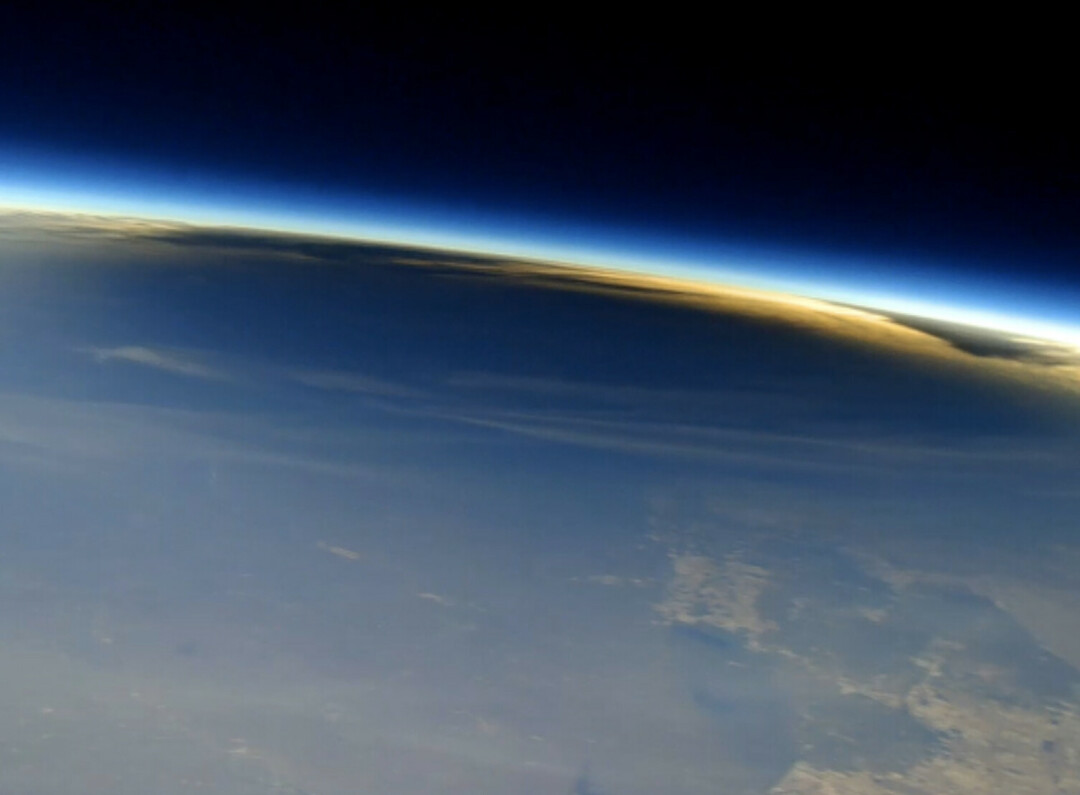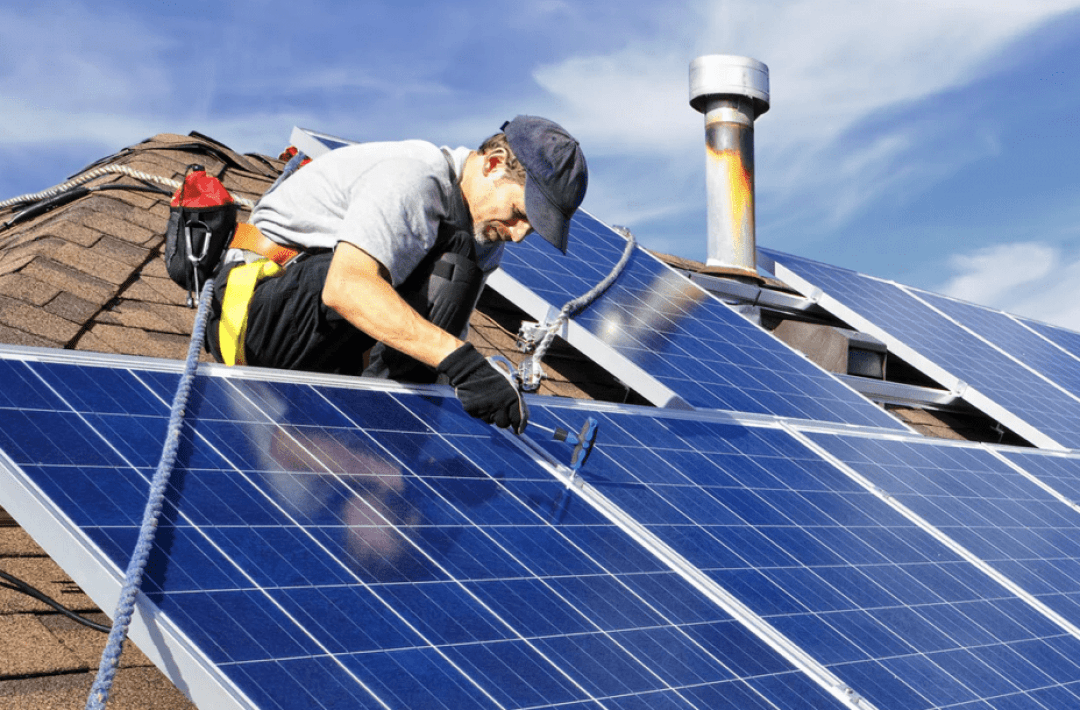 In this photo captured by a team from Virginia Tech, the moon's shadow on Earth during a total solar eclipse is captured from a high-altitude balloon April 8, 2024. The team is a part of the Nationwide Eclipse Ballooning Project founded at Montana State University. Photo courtesy Nationwide Eclipse Ballooning Project
In this photo captured by a team from Virginia Tech, the moon's shadow on Earth during a total solar eclipse is captured from a high-altitude balloon April 8, 2024. The team is a part of the Nationwide Eclipse Ballooning Project founded at Montana State University. Photo courtesy Nationwide Eclipse Ballooning Project
BOZEMAN – A Montana State University researcher has announced the first confirmed detection of eclipse-induced gravity waves in Earth’s stratosphere in data collected by students participating in an MSU-led nationwide atmospheric science program.
Angela Des Jardins, director of the Montana Space Grant Consortium and an associate professor in the Department of Physics in MSU’s College of Letters and Science, presented the findings Wednesday at the summer meeting of the American Astronomical Society. The conclusions were drawn from data collected last October by student participants in the Nationwide Eclipse Ballooning Project, a NASA- and National Science Foundation-sponsored program founded at MSU 10 years ago. During the past academic year, 53 teams of students from 75 institutions participated in the project, conducting advanced engineering and atmospheric science experiments from high-altitude balloons during the Oct. 14, 2023, annular and April 8, 2024, total eclipses.
The data Des Jardins presented were collected by four student atmospheric science teams during the annular eclipse, when the moon blocked all but the outer edge of the sun when viewed from the path of annularity. The four teams were stationed along that path in New Mexico, where conditions on Oct. 14 were ideal for sending weather balloons into the stratosphere every 15 minutes to collect pressure, temperature and humidity readings that were then collated into a high-resolution dataset.
Des Jardins said the data were processed and analyzed by a scientist at NASA Goddard Space Flight Center and NEBP students from Idaho and New York. The results confirm that the moon’s shadow during the eclipse lowered temperatures enough to generate atmospheric gravity waves. Gravity waves are common and normally generated by day-to-night temperature changes or features like mountain ranges. The data collected over New Mexico confirmed the hypothesis that the fast-moving cold, dark shadow cast by the moon during an eclipse creates a thermal shock that sends out ripples in the atmosphere, similar to the way a rock tossed into a pond sends out ripples in the water.
Data from the 15 other atmospheric science teams elsewhere along the path of annularity are still being analyzed, said Des Jardins, as are data from the April total eclipse collected by all 19 teams. She expects all the data to be published on the MSU Dryad system, a service that supports researchers in archiving and preserving data, by the end of 2024 so that anyone can view and analyze them.
This is the third time NEBP students have gathered evidence of eclipse-driven atmospheric gravity waves. The first was in Chile during a 2019 total eclipse, and a paper on those findings was published in the journal Nature in 2020. However, Des Jardins said, the data in 2019 were taken from just one site on flights launched hourly, rendering the results inconclusive. The second was again in Chile in 2020, but the data collected at those two sites was distorted by an atmospheric river, or large amounts of rainfall. NEBP designed the 2023 and 2024 experiments to yield higher-resolution data, and Des Jardins said the findings represent a significant scientific advancement.
“By observing how the atmosphere reacts in the special eclipse cases, we can understand more about the atmosphere in general, which can help us better predict the weather and model climate change,” she said.
During the two recent eclipses, NEBP also engaged 34 engineering teams from across the country – including the lead team based at MSU – to fly balloons carrying instruments, individually designed payloads and at least two types of cameras to livestream video and capture all-around images from a space-like perspective. Links to their interactive, 360-degree videos and a collection of images showing the moon’s shadow and curvature of the Earth against the blackness of space are available on the NEBP website at eclipse.montana.edu, with more to come.
Like their atmospheric science counterparts, the engineering teams were paying close attention to what was happening in the atmosphere as they went about their duties.
“We anticipated massive cooling during the eclipses – this occurred, and the air depressed,” said Mike Walach, MSU assistant professor in the Department of Agricultural and Technology Education and Montana Space Grant Consortium co-flight director. The depression caused the MSU team’s balloons floating at 85,000 feet above Fort Wayne, Indiana, on April 8 to descend to about 65,000 feet during the total eclipse – about twice as far as the team’s balloons dropped during the annular eclipse nearly six months before over Nevada, he said.
Walach said all the NEBP engineering teams experienced many triumphs, thanks in large part to engineering innovations developed and shared with them by the MSU team. Among those were improvements to the balloons’ helium-venting systems, which worked well on the ground but not at altitude during practice flights prior to the NEBP eclipses.
To figure out why, the MSU team used dry ice to cool the components to 50 degrees below zero – well below the temperature of the cold room where they had previously tried troubleshooting, but within the parameters encountered in Earth’s stratosphere – and the valves failed. Adding a heating system fixed the venting problem, but the vents interfered with the parachutes responsible for returning equipment safely to the ground after the balloons burst. To address that, the students devised a parachute-packing system. All the innovations were successful.
“People said you can’t vent helium off a balloon at altitude, but they did it,” Walach said, adding that the fixes allowed the balloons to remain at altitude for longer periods, prevented parachutes from tangling and gave ground-based pilots the ability to steer the balloons to different wind layers to better control their direction.
Just last week, Walach welcomed a new group of student interns who have begun working on yet more innovations to the system designed by their predecessors.
“The purpose behind the Nationwide Eclipse Ballooning Project was to teach other institutions academic ballooning, but we use it as a way of giving students in Montana an aerospace experience,” said Walach, who believes solving the engineering challenges provides students with invaluable technical, teamwork and communication skills that are highly valued by employers.
“This is pure research – they will make changes, then share and pass on that knowledge to the next group,” he said. “For undergraduates, it’s a good taste of what research is all about.”





 In this photo captured by a team from Virginia Tech, the moon's shadow on Earth during a total solar eclipse is captured from a high-altitude balloon April 8, 2024. The team is a part of the Nationwide Eclipse Ballooning Project founded at Montana State University. Photo courtesy Nationwide Eclipse Ballooning Project
In this photo captured by a team from Virginia Tech, the moon's shadow on Earth during a total solar eclipse is captured from a high-altitude balloon April 8, 2024. The team is a part of the Nationwide Eclipse Ballooning Project founded at Montana State University. Photo courtesy Nationwide Eclipse Ballooning Project

News Comments
Thank you
Open Auditions for Annie
Monday, Sep. 16, 2024
I’m at the Bozeman airport where your painting, “Blowing East” is displayed. It’s absolutely gorgeous! Bravo, Marci!!
The Artists’ Gallery in Bozeman’s Emerson Cultural Center May Exhibits
Sunday, Jun. 30, 2024
This is so typical of a sign in, which we should not have to do to check if we or some one in our party got a permit. I have been working or "creating an account" for 30 minutes and just get the same ...
Smith River permit drawing results available
Sunday, Mar. 10, 2024
I have struggled with this podcast and my own participation therein, the event itself obviously traumatic, but beyond that my inability to reach anyone and convey anything resembling truth. The person ...
Billings, MT Case Becomes True Crime Podcast | 'An Absurd Result'
Marktokarski
Saturday, Jan. 20, 2024